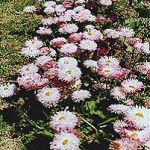| Common Name: |
English Daisy |
| Botanical Name: |
Bellis perennis |
| Genus: |
Bellis |
| Family: |
Asteraceae |
| Native Location: |
Europe and W Asia |
| Cultivation: |
Well-drained soil in sun or partial shade. Dead-head regularly to prolong flowering and avoid excessive self-seeding. May escape in lawns. |
| Propagation: |
By seed sown outdoors in early summer, or at 10-13°C (50-55°F) in early spring; by division in early spring, or after flowering. Double-flowered cultivars are usually sterile and cannot be raised from seed. |
| Harvest: |
Leaves are picked in spring and summer, and used fresh in decoctions, ointments, or poultices. Flowers are picked in spring and summer, and used fresh in infusions or ointments. |
| Variations: |
Alba Plena
Has pure white, double flowers
Dresden China
Has small, double, shell-pink flowers.
Prolifera
(hen-and-chickens daisy)
Known in Elizabethan times as the "childing daisy", has double white, often pink-flushed flowers that send out small ones from the main flower head.
Height: 10cm (4in)
Rob roy
Dates from c.1818 and has crimson double flowers
Height: 15cm (6in) |
| Height: |
2.5-15cm (1-6in) |
| Width: |
7-12cm (3-5in) |
| Hardiness: |
Z3-10 |
| Parts Used: |
Leaves, flowers |
| Properties: |
An astringent, healing, expectorant herb that relaxes spasms. |
| Medicinal Uses: |
Internally for coughs and mucus. Externally for ruptures, varicose veins, minor wounds, and sore or watery eyes. A homeopathic remedy for deep bruising. |
| Culinary Uses: |
Young leaves, flowers buds, and petals have a pleasant sour flavor and may be added to salads. Flower buds can be pickled in vinegar as a substitute for capers. |
| Bibliography: |
Encylopedia of Herbs by Deni Brown Copyright ©: 1995, 2001 Dorling Kindersley Limited pps. 141-142
|
